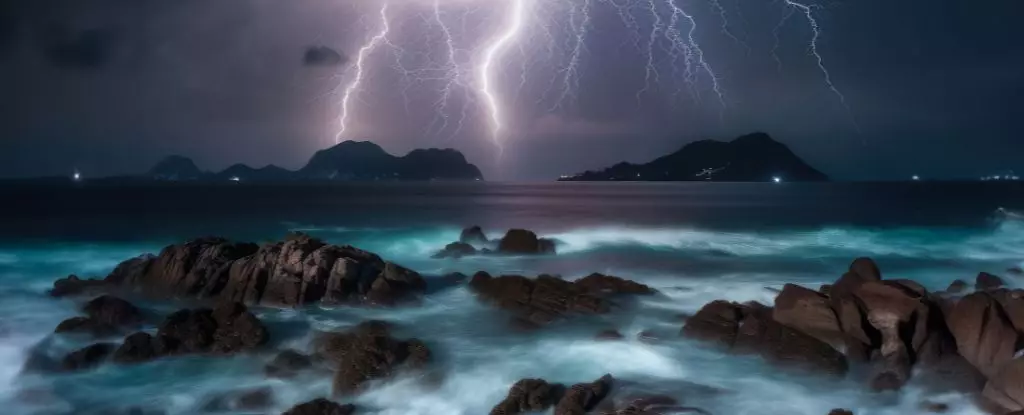The story of life’s origin is often tangled in grand theories that evoke images of primordial chaos—explosive lightning strikes illuminating dark skies as organic compounds are forcibly sculpted from the raw materials of the universe. Yet, recent research from Stanford University turns this narrative on its head, suggesting a far more subtle and eloquent emergence of life’s building blocks. Dubbed ‘microlightning,’ this discovery shines a light—pun intended—on a gentler method of molecular synthesis, challenging long-standing notions rooted in the static and violent parturition of life on Earth.
Microlightning: The Quiet Spark
Richard Zare and his team at Stanford have unearthed a captivating phenomenon: tiny electric discharges between charged water droplets can effectively produce organic compounds essential for life. Rather than envisioning life arising amidst a storm, this research proposes an almost serene backdrop where charged microdroplets, dancing in a mist, generate tiny bursts of energy that promote chemical bonding. The magic here isn’t just in the chemistry but in the way these researchers have reframed our understanding of how life might first have emerged.
Whereas the Miller-Urey experiment of 1952 showcased the vibrant possibilities of life’s assembly through high-voltage electricity, the concept of microlightning offers an intimate and intricate portrait of creation. The intricate interplay of water, light, and gas posits an optimistic view of life’s possible emergence across vast cosmic landscapes, reinforcing the notion that life is not a freak accident but perhaps a natural consequence wherever the right conditions exist.
Challenging the Status Quo
It’s essential to critique the reductionist approach that often pervades scientific discussions about life’s origins. For decades, scholars have deemed the Miller-Urey experiment a cornerstone of abiogenesis, yet its relevance to actual Earth conditions has always been contestable. The stark conditions faced in laboratory settings starkly contrast with those in Earth’s early oceans. Microlightning, with its gentle sparks rather than vibrant flashes, introduces a refreshing perspective that encourages us to look beyond one specific hypothesis and entertain multiple avenues for life’s genesis.
The researchers have drawn attention to a critical point: the importance of water sprays in potential life-forming environments. Contrary to popular depictions of life’s emergence as being tumultuous and chaotic, this insight reveals a less tumultuous but equally vibrant possibility. Zare’s propositions may serve as a gateway to understanding life as an inevitable byproduct of chemical processes, wherever water is available—in crevices, on the surfaces of rocks, or within clouds.
Broader Implications for the Universe
The implications of this research are profound. If microlightning can initiate the synthesis of organic compounds, then similar phenomena could be happening elsewhere—on distant planets or moons where water exists. The ubiquity of water in the universe suggests that life might not just be Earth-bound but could exist in various forms throughout the cosmos. This perspective fills one with optimism—life, it seems, requires neither extraordinary circumstances nor perfect conditions but merely a compliance of elemental artistry.
Moreover, the synergy of microdroplets and gaseous exchanges indicates an intricate landscape of possibilities for biochemistry, hinting at a universe replete with potential life-forming scenarios. While other theories, such as contributions from meteorite impacts or the delivery of complex molecules by comets, remain valid, exploring the interactions of these minute electrical phenomena offers a nuanced understanding of life’s resilience and adaptability.
The Artistic Dance of Chemistry
Much of our discourse surrounding the origins of life approaches this topic analytically and scientifically. Yet, we might consider approaching it as an art form—an intricate dance of molecules guided by the invisible hand of physics. The notion that life emerged not in chaos, but in the gentle cadences of microscopic energies, reveals an aspect that is profoundly poetic. It calls upon viewers not merely to engage with the science but to ponder the artistry of existence itself.
As we delve deeper into these findings, let us remain open to the myriad ways life could manifest—whether through microlightning, enigmatic interstellar journeys, or the terrestrial ballet between methane and ammonia. Life’s origins are undoubtedly complex, often challenging our sensibilities. Yet, with each revelation, we inch closer to unraveling the beautiful mystery that is our very existence, eventually transforming the rhetoric from what was once a battle of thunderous chaos into one of cosmic grace.


Leave a Reply